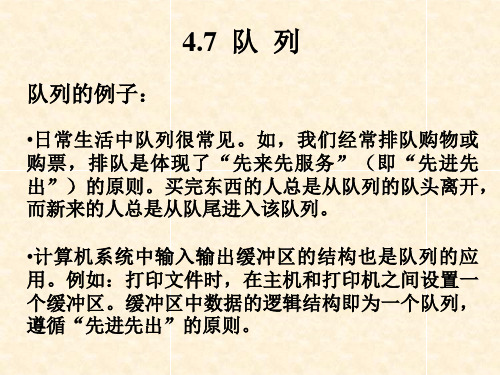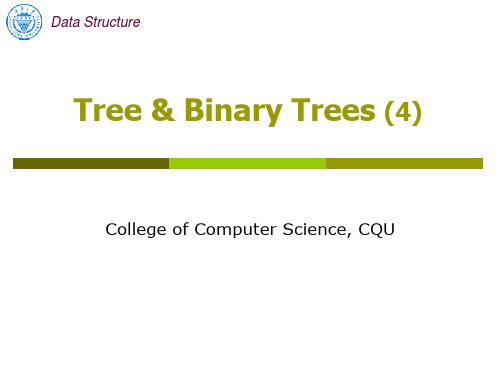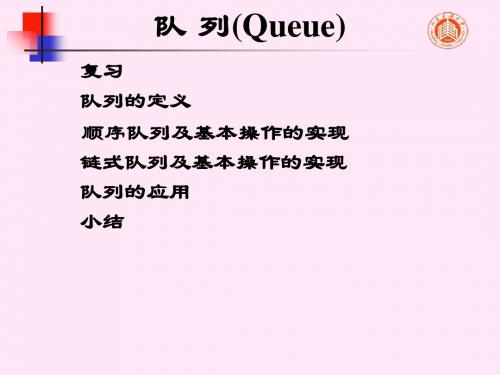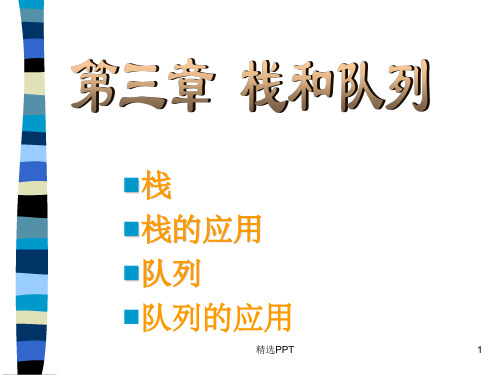重庆大学数据结构英文课件Queue
六DA0901_Queue

10
链式队列类的实现
// Linked queue class class LQueue implements Queue { private Link front; // Pointer to front node private Link rear; // Pointer to rear node public LQueue() { setup(); } // Constructor public LQueue(int sz) { setup(); } // Constuctor
A. 6
B. 4
C. 3
D. 2
19
小练习
已知Q是一个非空队列,S是一个空栈。仅用队列和栈的ADT函数和少量工作变 量,编写一个算法,将队列Q中的所有元素逆置。 栈的ADT函数有: push(object it) ; object pop( ); boolean isEmpty( ) ; //新元素value进栈 //出栈,返回栈顶值 // 判栈空否
队列的顺序表示
用一维数组elements [maxSize]作为存贮结构,设置队首 front和队尾rear指针,初始值均应置为0 插删分别令rear和front指针加1:
当rear = maxSize - 1,队列满,若再插将出现上溢,但实 际是假溢出
3
假上溢
尽管队列中实际的元素个数 远远小于向量空间的规模, 但也可能由于尾指针已超出 向量空间的上界而不能做入 队操作。该现象称为假上溢。 克服上述假上溢现象的方法 是将向量空间想象为一个首 尾相接的圆环。头尾指针随 着插删的操作在圆环中移动。 除非向量空间真的被队列元 素全部占用,否则不会上溢。 r
《数据结构栈和队列》课件

网络通信
在网络通信中,数据包按 照到达顺序进入队列,等 待处理。
打印任务管理
打印任务按照到达顺序进 入队列,等待打印机的空 闲时间进行处理。
05
栈与队列的比较
结构比较
栈和队列是两种不同的数据结构,它们在结构上有明显的区 别。
课程目标
掌握栈和队列的基本 概念、原理和应用场 景;
能够运用栈和队列解 决实际问题和算法设 计。
理解栈和队列在解决 实际问题中的作用和 优势;
02
数据结构概述
数据结构定义
数据结构定义
数据结构是数据元素之间相互关系和数据元素属性的 抽象表示。
数据结构组成
数据元素、数据元素之间的关系和数据元素的属性。
表达式求值:例如,括号内的运算优先级高于括号外的运算,可以使用栈来保存括 号和运算符,以便正确地计算表达式的值。
深度优先搜索(DFS):在图的遍历中,可以使用栈来保存待访问的节点,实现深 度优先搜索。
04
队列(Queue)
队列的定义
01
队列是一种先进先出(FIFO)的数据结构,用于存储元素的集 合。
07
总结与展望
本章总结
栈和队列是两种常见的数据结构,具有特定的操作规则和特性。
通过学习栈和队列,我们掌握了先进先出(FIFO)和后进先出(LIFO)的 原理,以及如何在程序中实现这些数据结构。
本章还介绍了栈和队列在实际问题中的应用,如括号匹配、表达式求值等 。
数据结构的发展趋势与未来展望
01
随着计算机技术的不断发展,数据结构也在不断演进
02
队列中的元素遵循先入队后出队的规则,即最早进入队列的元
《数据结构课件队列》课件

双端队列的实现
双端队列是一种具有前后端两个出入口的队列,允许从两端插入删除元素。
队列的几种常见错误操作
1 插入空队列
尝试在空队列中执行出队操作。
3 队列溢出
尝试向已满的队列中插入元素。
2 删除空队列
尝试从空队列中执行出队操作。
循环队列的实现
循环队列通过标记队列的前后端指针,使得队列中的元素可以重复利用的数据结构表示方法。
阻塞队列的实现
阻塞队列在队列为空时,阻塞出队操作,而在队列满时,阻塞入队操作的数 据结构表示方法。
并发队列的实现
并发队列是多线程环境下的队列实现,能够安全地处理多个线程之间的并发 操作。
队列的应用举例:生产者和消费者问题
队列的特点
1 先进先出
队列中的元素按照插入的顺序处理。
2 只能在前后端进行操作
只能在队列的前端进行删除(出队)操作,而在队列的后端进行插入(入队)操作。
3 常用操作为入队和出队
常用的队列操作是将元素插入队列(入队)或删除队列中的元素(出队)。
队列的应用场景
任务调度
队列用于按照优先级处理任务。
缓存
4 非法操作
在队列中进行不支持的操作。
队列性能分析
队列的性能取决于具体实现的数据结构和操作,包括插入、删除、查看队首 元素的时间复杂度。
队列和栈的比较
队列和栈都是常见的数据结构,但队列遵循FIFO原则,而栈遵循LIFO原则。
队列在算法设计中的应用
队列在算法设计中经常用于解决广度优先搜索、树的层序遍历等问题。
《数据结构课件队列》PPT课 件
欢迎阅读《数据结构课件队列》PPT课件!在本课程中,我们将探讨队列的 定义、特点、应用场景以及其在数据结构中的表示和操作。我们将介绍不同 类型的队列,实现并发和阻塞队列,以及队列在算法设计和常见面试题中的 应用。
数据结构Queues队列

网络通信
在网络通信中,队列用于存储待处理 的网络数据包,以便按照顺序进行处 理。
银行排队系统
银行排队系统中,客户按照到达顺序 进入队列等待办理业务。
02
队列的基本操作
入队操作
01 入队(Enqueue)
将一个元素添加到队列的末尾。
02 时间复杂度
在大多数实现中,入队操作的时间复杂度为O(1), 因为通常可以在常数时间内将元素添加到队列的 末尾。
详细描述
循环队列是一种改进的数组实现方式,通过使用两个指针分别指向队列头部和尾部,以及一个表示队 列总容量的变量来实现。当队列为空时,头部和尾部指针都指向队列的起始位置;当队列满时,头部
和尾部指针都指向队列的结束位置。循环队列通过循环利用数组空间来避免数组空间的浪费。
队列的常见操作时间复杂度
04
分析
总结与展望
队列的重要性和应用价值
01 队列是一种先进先出(FIFO)的数据结构,广泛 应用于计算机科学和信息技术领域。
02 队列在操作系统、网络通信、数据库管理、图形 渲染等方面具有重要作用,能够高效地处理任务 调度、缓冲区管理、事件驱动等场景。
02 队列在算法设计和数据结构领域中也是重要的基 础组件,对于提高程序性能和解决复杂问题具有 关键作用。
出队操作的时间复杂度
总结词
出队操作的时间复杂度也取决于队列 的实现方式和底层数据结构。
详细描述
在链表实现的队列中,出队操作通常需要O(1) 的时间复杂度,因为只需访问链表的头部元素。 而在数组实现的队列中,出队操作可能需要 O(n)的时间复杂度,因为可能需要移动数组中 的所有元素来填补被移除的元素的空间。
详细描述
链表实现队列时,通常使用两个指针分别指向队列头部和尾部。入队操作在尾部进行,出队操作在头 部进行。当队列为空时,头部和尾部指针都指向队列的起始位置;当队列满时,头部和尾部指针都指 向队列的结束位置。由于链表的大小是动态的,因此队列的大小也是动态的。
数据结构Chap5 queue

数据结构Chap5 queue在计算机科学中,数据结构是组织和存储数据的方式,以便能够有效地进行操作和访问。
而队列(queue)作为一种常见的数据结构,在许多程序和算法中都发挥着重要的作用。
想象一下,在生活中我们去银行办理业务,人们会排成一列队伍,先到的先办理,后来的依次排队等待。
队列的工作方式就类似于这样的排队场景。
队列遵循着“先进先出”(First In First Out,简称 FIFO)的原则。
这意味着,最先进入队列的元素将最先被取出。
就好像在银行排队中,最早到达的人会最先得到服务并离开队伍。
队列有两个主要的操作:入队(enqueue)和出队(dequeue)。
入队是将元素添加到队列的末尾,而出队则是从队列的前端移除元素。
为了实现一个队列,我们可以使用数组或者链表。
如果使用数组来实现队列,我们需要确定队列的前端和后端的位置。
通常,我们会用一个变量来记录前端的位置,用另一个变量来记录后端的位置。
当进行入队操作时,如果后端到达了数组的末尾,我们可能需要进行一些特殊的处理,比如将元素重新放置到数组的开头,以实现循环队列的效果。
链表实现队列则相对灵活一些。
每个节点包含数据和指向下一个节点的指针。
入队时,我们在链表的末尾添加新节点;出队时,我们删除链表的头节点。
队列在计算机科学中有广泛的应用。
比如,操作系统中的任务调度常常使用队列来管理等待执行的任务。
新的任务被放入队列,而处理器会按照队列的顺序依次处理任务。
在网络通信中,数据包的传输也可能用到队列。
当网络拥塞时,数据包会被暂时存储在队列中,等待有可用的带宽时再进行传输。
在程序设计中,我们可以使用队列来实现广度优先搜索算法。
在这种算法中,我们从起始节点开始,依次将相邻的未访问节点放入队列,然后按照队列的顺序逐个访问这些节点。
再举个例子,打印队列也是队列的常见应用场景。
多个用户向打印机发送打印任务,这些任务会按照发送的顺序排队等待打印。
总之,队列是一种简单但非常实用的数据结构。
(数据结构课件)队列

2. 链队的操作实现
(3)判别队空 函数名:EmptyQueue 形参:链队HQ 返回值:若链队为空返回true,否则返回false 功能:判断链队是否为空,即判断队首指针
HQ.front或队尾指针HQ.rear是否为NULL。这两个指 针任何一个为空时,另一个必定也为空。
出队
a1 a2 a3
…
ai
…
an
front
rear 队列的示意图
进队
4.7.3 队列的顺序存储结构和操作实现
当插入新的数据元素时,队尾指针rear+1,而当队 头元素出队列时,队头指针front+1。
下图给出了队列中头尾指针的变化状态。
rear=0
A
front=0 (a)
rear=4 front=0
尾。分两步:1)为新元素分配内存空间; 2)把新元素插入到队尾:
•若原链队为空,则插入后只有一个结点,队首和 队尾指针都指向该点,即 HQ.front=HQ.rear=newptr;
•若原链队非空,则修改队尾指针。先将新结点插 入到队尾:HQ.rear->next=newptr; 然后修改得 到新的队尾指针:HQ.rear=newptr;
应该掌握:
• 栈的顺序存储结构的表示 GO
• 栈的链接存储结构的表示
• 队列的顺序存储结构 GO
GO
• 队列的链接存储结构
GO
• 顺序栈(入栈操作、出栈操作)
• 链栈(入栈操作、出栈操作)
• 顺序队列(入队操作、出队操作)
• 链队(入队操作、出队操作)
• 栈应用之一——算术表达式的计算
测试题:
• 假定利用数组a[N]顺序存储一个栈,用top表示栈顶指针, top= = -1表示栈空,并已知栈未空,当退栈并返回栈顶元 素时所执行的操作为________________。
重庆大学数据结构英文课件Trees_04

11
Building Human Trees
Create a collection of n initial Huffman trees, each of which is a single leaf node containing one of the letters. Put the n partial trees onto a priority queue organized by weight (frequency). Next, remove the first two trees (the ones with lowest weight) from the priority queue. Join these two trees together to create a new tree whose root has the two trees as children, and whose weight is the sum of the weights of the two trees. Put this new tree back into the priority queue. This process is repeated until all of the partial Huffman trees have been combined into one.
Data Structure
Tree & Binary Trees (4)
College of Computer Science, CQU
Outline
Introduction Weighted Path Length Huffman tree Huffman Codes
数据结构课件第3篇章栈和队列

循环队列实现原理
01
循环队列定义
将一维数组看作首尾相接的环形结构,通过两个指针(队头和队尾指针)
在数组中循环移动来实现队列的操作。当队尾指针到达数组末端时,再
回到数组起始位置,形成循环。
02
判空与判满条件
在循环队列中,设置一个标志位来区分队列为空还是已满。当队头指针
等于队尾指针时,认为队列为空;当队尾指针加1等于队头指针时,认
栈在函数调用中应用
函数调用栈
在程序执行过程中,每当发生函数调用时,系统会将当前函数的执行上下文压入一个专门的栈中,称为函数调用 栈。该栈用于保存函数的局部变量、返回地址等信息。当函数执行完毕后,系统会从函数调用栈中弹出相应的执 行上下文,并恢复上一个函数的执行状态。
递归调用实现
递归调用是一种特殊的函数调用方式,它通过在函数调用栈中反复压入和弹出同一函数的执行上下文来实现对问 题的分解和求解。在递归调用过程中,系统会根据递归深度动态地分配和管理函数调用栈的空间资源。
栈和队列的应用
栈和队列在计算机科学中有着广泛的应用,如函数调用栈、表达式求 值、缓冲区管理等。
常见误区澄清说明
误区一
栈和队列的混淆。虽然栈和队列都是线性数据结构,但它们的操作方式和应用场景是不同的。栈是后进先出,而队列 是先进先出。
误区二
认为栈和队列只能通过数组实现。实际上,栈和队列可以通过多种数据结构实现,如链表、循环数组等。具体实现方 式取决于应用场景和需求。
后缀表达式求值
利用栈可以方便地实现后缀表达式的求值。具体步骤 为:从左到右扫描表达式,遇到数字则入栈,遇到运 算符则从栈中弹出所需的操作数进行计算,并将结果 入栈,最终栈中剩下的元素即为表达式的结果。
中缀表达式转换为后缀表达式
数据结构课件第3篇章队列

PART 01
队列基本概念与特性
队列定义及操作规则
队列(Queue)是一种具有先进先出(FIFO)特性的线性表,只允许在一端(队尾) 插入元素,而在另一端(队头)删除元素。
队列中没有元素时,称为空队列。
队列的基本操作包括:入队(在队尾插入一个元素)、出队(删除队头元素)、判 空(判断队列是否为空)、查看队头元素等。
队列与栈的区别与联系
01
区别
02
队列遵循先进先出(FIFO)原则,而栈遵循后进先出 (LIFO)原则。
03
队列只允许在一端插入元素,在另一端删除元素;而栈只 允许在一端进行插入和删除操作。
04
联系
05
队列和栈都是线性结构,数据元素之间存在一对一的线性 关系。
06
它们都可以用来存储具有相同数据类型的数据元素,且元 素的插入和删除操作都受到一定限制。
LRU缓存淘汰算法
在实现LRU(Least Recently Used)缓存淘汰算法 时,可以使用双端队列来维护缓存中的元素。通过 双端队列的插入和删除操作,可以高效地实现缓存 的更新和淘汰。
其他应用
除了上述应用外,双端队列还可以应用于其他场 景,如实现回文检查、处理字符串反转等问题。
PART 06
取出一个进程进行处理。
03
网络通信
在网络通信中,数据的传输往往采用队列的方式进行。发送方将数据放
入发送队列中,接收方从接收队列中取出数据进行处理。这种方式可以
保证数据的顺序性和可靠性。
PART 02
顺序队列实现原理及方法
顺序队列存储结构介绍
பைடு நூலகம்
存储结构定义
顺序队列是采用一维数组作为存储 结构,遵循队列先进先出(FIFO) 的原则进行数据的存取。
数据结构6 队列

链式队列的实现
java语言描述:
循环链式队列的讨论
public class SingleLinkedQueue<AnyType> { private Node<AnyType> front,back; //队头、队尾 private int currentSize;
public SingleLinkedQueue() {front=back=null; currentSize=0; }
(a) 1), a2),a3,)…)an-1),an) 出队过程
(…a) 213n,-)a1…a,na32-1na,a…,)na3-1n,a…,)ann-1a),na-n1), an)
a1 a2 a3 …… an-1 an 队的特点:先进先出(First In First Out)
队列的数组实现
队列的逻辑形态 0 1 2 34 5
银行业务的抽象
服务柜台
角色和过程
顾客
何时来到银行?
需要多长的办理时间?
事件
顾客到来
顾客离开
加入最短的队列 下一个顾客得到服务
Байду номын сангаас 小结
队列的基本概念 链式队列 顺序队列 队列应用
特殊的线性表 先进先出 主要的操作:入队、出队
带头结点的单链表
入队、出队等操作的实现 循环队列解决假溢出 队空和队满的判定 入队、出队、长度的表达式 如何实现的循环?
a1 a2 a3
front
back
每一个队列的数据结构,用一个数组theArray以及 位置front和back来表示,同时还需记录实际存于队 列中的元素的个数currentSize。
队列的数组实现
《数据结构课件队列》PPT课件

front
J6 J5 4 5 0 J7
31 J4 2 J8
rear
精选PPT
11
队空:front==rear 队满:front==rear
J6
J5 5
4
0
J4
3
1 2
rear
5
4
0
3
1
2
front rear
front
J5 初始状态
J4
解决方案: 1.另外设一个标志以区别队空、队满
front
2.少用一个元素空间:
(a0, a1, ... , ai -1, ai , ai+1, …, an-1 )
删除
精选PPT
插入
2
a a a a front
rear
0 1 2 …… n-1
队
队
头
尾
队列的示意图
队列的特点 先进先出
说明:
第一个入队的元素在队头, 最后一个入队的元素在队尾, 第一个出队的元素为队头元素, 最后一个出队的元素为队尾元素
4.取队头元素 GetHead(Q,&e)
得到队列Q的队头元素之值,并用e返回其值。
5.判队空 QueueEmpty(Q)
判断队列Q是否为空,若为精选空PP返T 回1,否则返回0。
4
3.4.2 非循环队列和循环队列
分配一块连续的存储区域来存放队列里的元素。由 于队列的队头和队尾的位置是变化的,因而要设两个 指针和分别指示队头和队尾元素在队列中的位置。
为充分利用向量空间,克服上述假上溢现象,可以
将向量空间想象为一个首尾相接的圆环,并称这种
向量为循环向量,存储在其中的队列称为循环队列
重庆大学数据结构ppt10_Queue

‘c’ ‘b’ ‘b’ ‘a’
Dequeue
‘c’ ‘b’
‘a’
‘a’
Data Structure
Queue
Queue ADT
// Abstract queue class template <typename E> class Queue { private: void operator =(const Queue&) {} // Protect assignment Queue(const Queue&) {} // Protect copy constructor public: Queue() {} // Default virtual ˜Queue() {} // Base destructor
‘c’
3
General Equations: front = (front+1)%N; rear = (rear+1)%N;
‘d’
4
Data Structure
Queue Implementation (2)
How can we recognize when the circular queue is empty or full?
Data Structure
Queue
Queue
FIFO: First in, First Out It means: the first element inserted is the first one to be removed Example: The first one in line is the first one to be served
Data Structure
《数据结构》课堂课件3

3.2 Implementations of Queue
17
Linear Implementation
Two indices(下标) to keep track of both the front and the rear of the queue
To serve an entry, take the entry and increase the front by
All
additions to the list are made at one end, and all deletions from the list are made at the other end
3.1
3.1 Definitions
5
4 3 2 1 2 1 2 1
Front and rear
Outline
1
2
3
3.3 Circular Implementation of Queues in C++
Const int maxqueue=10;
1.
class Queue { 2. public: Queue(); bool empty() const; Error_code serve(); Error_code append(const Queue_entry &item); Error_code retrieve(Queue_entry &item) const; 3. protected: int count; 4. int front,rear; Queue_entry entry[maxqueue]; };
6
5 4
7
- 1、下载文档前请自行甄别文档内容的完整性,平台不提供额外的编辑、内容补充、找答案等附加服务。
- 2、"仅部分预览"的文档,不可在线预览部分如存在完整性等问题,可反馈申请退款(可完整预览的文档不适用该条件!)。
- 3、如文档侵犯您的权益,请联系客服反馈,我们会尽快为您处理(人工客服工作时间:9:00-18:30)。
Data Structure
04 Queue
Queue Implementation (1)
Data Structure
04 Queue
Queue Implementation (1)
ðp
This implementation raises a new problem.
ðn
When elements are removed from the queue, the front index increases. Over time, the entire queue will drift toward the higher-numbered positions in the array. Once an element is inserted into the highest-numbered position in the array, the queue has run out of space. This happens despite the fact that there might be free positions at the low end of the array where elements have previously been removed from the queue.
2 c b d
3
0 head
a 4 5
tail
Data Structure
04 Queue
Circular Queue Demo
ðp
A refinement of the lazy approach is the circular queue
head = tail = 0; enQueue enQueue enQueue enQueue enQueue (q, (q, (q, (q, (q, ‘a’); ‘b’); ‘c’); ‘d’); ‘e’); 1
Data Structure
04 Queue
Queues
FIFO: First in, First Out Restricted form of list: Insert at one end, remove from the other. Notation:
ðp ðp ðp ðp
Insert: Enqueue Delete: Dequeue First element: Front Last element: Rear
head = tail = 0; enQueue (q, ‘a’); 1
2
3
tail head
Data Structure
0 5
4
04 Queue
Circular Queue Demo
ðp
A refinement of the lazy approach is the circular queue
Data Structure
04 Queue
Array_based Queue
ðp
The array-based queue is somewhat tricky to implement effectively. Assume that there are n elements in the queue. ðn If we choose the rear element of the queue to be in position 0, enqueue operations will shift the n elements currently in the queue one position in the array. ðn If instead we chose the rear element of the queue to be in position n-1, a dequeue operation must shift all of the elements down by one position to retain the property that the remaining n1 queue elements reside in the first n-1positions of the array. ðn A far more efficient implementation can be obtained by relaxing the require-ment that all elements of the queue must be in the first n positions of the array.
2 c b d e
3
enQueue (q, ‘f’); ??? head
Data Structure
0
a
4
5
04 Queuetail
Circular Queue Demo
ðp
A refinement of the lazy approach is the circular queue
Empty: head == tail; Full: tail+1 == head ??? 1 General Equations: head = (head+1)%N; tail = (tail+1)%N; head
Data Structure
04 Queue
2
Queues
ðp
Like the stack, the queue is a list-like structure that provides restricted access to its elements.
ðp
Queue elements may only be inserted at the back (called an enqueue operation) and removed from the front (called a dequeue operation).
head = tail = 0; enQueue enQueue enQueue enQueue (q, (q, (q, (q, ‘a’); ‘b’); ‘c’); ‘d’); 1
2 c b
tail 3
0 head
Data Structure
a 4 5
04 Queue
Circular Queue Demo
ðn
ðn
Another solution is to make the array be of size n+ 1, and only allow n elements to be stored.
Data Structure
04 Queue
Circular Queue Demo
ðp
A refinement of the lazy approach is the circular queue
Data Structure
04 Queue
Queue Implementation (2)
Data Structure
04 Queue
Queue Implementation (2)
ðp
How can we recognize when the circular queue is empty or full?
tail head = tail = 0; enQueue (q, ‘a’); enQueue (q, ‘b’); enQueue (q, ‘c’); 1
2
b
3
0 head
Data Structure
a 4 5
0ቤተ መጻሕፍቲ ባይዱ Queue
Circular Queue Demo
ðp
A refinement of the lazy approach is the circular queue
Data Structure
04 Queue
Queue ADT
// Reinitialize the queue. The user is responsible for // reclaiming the storage used by the queue elements. virtual void clear() = 0; // Place an element at the rear of the queue. // it: The element being enqueued. virtual void enqueue(const E&) = 0; // Remove and return element at the front of the queue. // Return: The element at the front of the queue. virtual E dequeue() = 0; // Return: A copy of the front element. virtual const E& frontValue() const = 0; // Return: The number of elements in the queue. virtual int length() const = 0; };
head = tail = 0; enQueue (q, ‘a’); enQueue (q, ‘b’); 1
2
tail
3
0 head
Data Structure
a 4 5
04 Queue
Circular Queue Demo
ðp
A refinement of the lazy approach is the circular queue
Data Structure
04 Queue
Queue Implementation (2)
